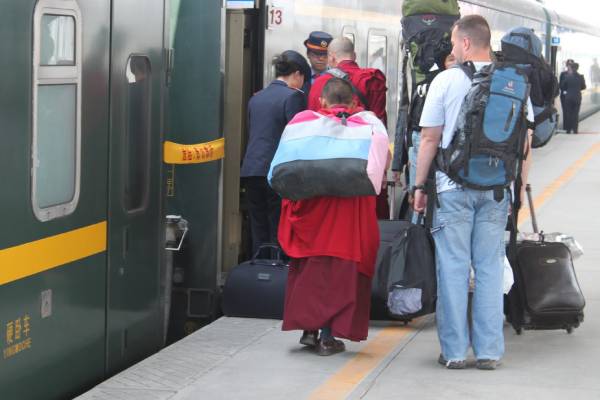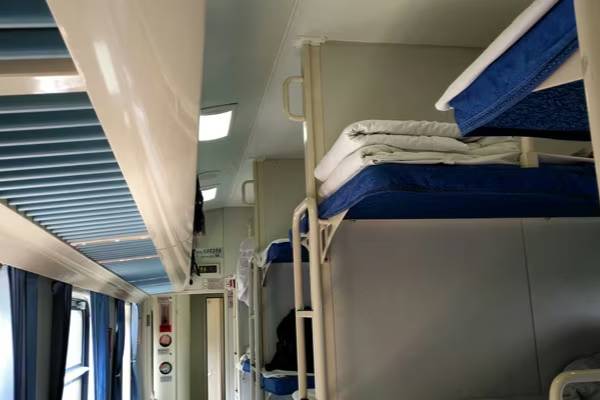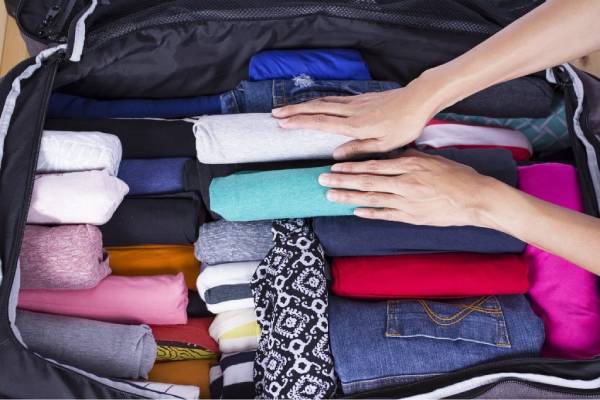Luggage Policies on Tibet Trains: Allowances, Restrictions & Storage Tips
As you prepare for your journey to Tibet, it’s essential to get familiar with the luggage policies on Tibet trains. Given the long distance of this trip, you’ll likely have quite a bit of luggage to bring along. But once you’ve gone through this guide, you’ll have a way better idea of what you can take, what’s not allowed, and how much you’re actually permitted to bring along.
CONTENT
How Much Luggage is Allowed on Tibet Trains?
1.Weight Limits
Different travelers get different weight allowances:
For most ordinary passengers, you are allowed to carry up to 20 kilograms (44 pounds) of luggage for free. This limit is enough for carrying your essentials like clothing, toiletries, and travel documents.
For children who are under 16 years old and under 1.6 meters (5.2 feet) in height, their limit is 10 kilograms (22 pounds). This is designed to cover their personal items, such as toys, snacks, and a change of clothes.
For diplomats, due to their specific travel needs, they can carry 35 kilograms (77 pounds) of free luggage.
2.Size Limits
If you carry a piece of regular luggage, then its total dimensions (length + width + height) must not exceed 160 centimeters (63 inches). Only within this limit, your luggage can fit under seats, in overhead racks, or in compartment storage spaces.
If you have rod-shaped items such as hiking poles, fishing rods, or tent poles with you, then their length must be less than 200 centimeters (79 inches).
3.Key Points to Note
Mobility aids for disabled passengers: Folding wheelchairs, crutches, and other mobility devices will not be counted toward your weight or size limits.
Practical enforcement of luggage policies: Station staff rarely weigh or measure luggage unless they’re super obviously over the normal size or weight. But that doesn’t mean you can just ignore the rules—overly large items can block aisles or bring inconvenience to other passengers.
Excess luggage solutions: If your luggage exceeds the limits, go for the consignment service at the station. Costs are reasonable (around 1.5-3 CNY per kilogram), depending on the weight of your luggage and the transportation distance.
Light and smart packing: The limits are generous enough for most travelers, so do not overpack and put yourself under unnecessary stress. Distribute heavy items across smaller bags instead of using one massive suitcase. This makes it easier to carry and store your luggage on the train.
 Travelers with bags and suitcases of various sizes are getting ready to board the trains to Tibet.
Travelers with bags and suitcases of various sizes are getting ready to board the trains to Tibet.What Items Are Limited on Tibet Trains?
1.Lighters and Matches
For the fire safety on the train, you may carry up to 2 ordinary lighters. And safety matches must not exceed 2 small boxes. In case they accidentally light up, better to keep them in your carry-on instead of checked luggage.
2.Personal Care Products
A lot of everyday toiletries have flammable or corrosive ingredients, so there’s a cap on how much you can bring:
Nail polish and delustering agents: The total volume must not exceed 50 milliliters.
Alcoholic beverages (with 24-70% alcohol): Must be in intact packaging with clear labeling, and their total volume must not exceed 3,000 milliliters. Products with more than 70% alcohol are prohibited entirely.
Aerosol containers such as cold perm lotion, hair dye, mousse, hair gel, insecticide, and air freshener: Each single container must not exceed 150 milliliters in volume, and only 1 piece of each type is allowed, and the total volume must not exceed 600 milliliters.
Non-aerosol container daily necessities containing flammable ingredients, such as perfume, toilet water, spray, and gel: Each single container must not exceed 100 milliliters in volume, and only 1 piece of each type is allowed.
Pro tip from our team: Transfer liquids into smaller, travel-sized containers to stay within limits. This also saves space in your bag!
3.Live Animals
For most of the time, live animals are not allowed on Tibet trains—but there are a few exceptions:
Service animals, like guide dogs for people with visual impairments or hearing dogs, are allowed. Just make sure you’ve got official papers that prove they’re trained and what they’re for.
Small, caged animals (like hamsters or birds) may be allowed in limited quantities, but this is at the discretion of station staff. Always check with your local railway authority at least a week before travel.
We rarely recommend traveling with pets to Tibet, as the long journey can stress them, and facilities for animals are limited at stations and in Tibet itself.
 Here are some items restricted on trains, such as lighters, nail polish, alcoholic beverages, etc.
Here are some items restricted on trains, such as lighters, nail polish, alcoholic beverages, etc.What Objects Are Prohibited on Tibet Trains?
1.Dangerous Goods
These are items that pose a risk of fire, explosion, or harm to passengers:
Explosives (firecrackers, dynamite), firearms, ammunition, and controlled knives.
Flammable substances: Gasoline, kerosene, and large quantities of alcohol (over 70% alcohol).
Toxic or corrosive materials: Pesticides, strong acids, and industrial chemicals.
Radioactive materials or unidentified chemicals (any substance with unclear labeling).
2.Unsanitary or Odorous Items
To keep a comfortable environment for all passengers:
Non-service animals (pets, livestock) are not permitted, as they can spread diseases or cause distress.
Items with strong, unpleasant odors are banned, for example, unsealed fermented foods, garbage, or chemical cleaners with pungent smells.
3.Damaging Items
Objects that could harm the train or its facilities are prohibited:
Sharp tools without proper packaging (e.g., unboxed knives longer than 15 centimeters, axes).
Corrosive substances that might stain seats or floors (open paint cans, acid-based cleaners).
Heavy items likely to scratch or dent surfaces (unwrapped metal furniture, large machinery parts).
What Baggage Services are Available at Tibet Train Stations?
1.Luggage Storage
If you arrive at the station early, you can store your luggage first, then go to enjoy a nice meal or visit nearby attractions if time permits.
Most stations offer 24-hour luggage storage services, and the storage areas are usually near the entrance. Right now, they mainly use smart lockers or have staff handle it manually. How much it costs depends on the size and number of bags—usually between 5 and 30 yuan.
When you store your stuff, you’ll need to show your ID and train ticket info. They’ll put a tag on your luggage, so make sure you hold onto the receipt or ticket—you’ll need it to get your bags back later.
2.Baggage Consignment
For passengers with large or heavy luggage that’s inconvenient to carry onboard, Tibet train stations provide baggage consignment services—you can entrust your luggage to the railway for transportation, and collect it upon arrival at your destination station.
Here’s how it works: Go to the designated consignment counter with your ID card or valid identity document and train ticket. The staff will weigh your bags and charge you based on how heavy/big the luggage is and how far it’s going.
Each piece of luggage has a maximum weight of 50 kilograms. For external dimensions, the sum of length, width and height must not exceed 200 cm at most, and must not be less than 60 cm at least. Generally speaking, your luggage is transported along with the train you are taking or in advance.
When you arrive, you can claim your luggage with the valid identity document used when purchasing the ticket.
3.Red Cap Baggage Handling Services
"Red Cap" refers to porters in uniform with red caps. You’ll spot them around station entrances, ticket counters, and platforms. This service is really helpful if you have heavy bags or multiple pieces of luggage.
These Red Cap porters can help carry your bags from the station entrance all the way to the train, help stow them away, and even assist with unloading when you reach your destination. How much you need to pay for their help depends on how many bags you have and how far they need to carry them.
Where Can You Store Luggage on Tibet Trains?
For passengers with different types of train tickets—soft sleeper, hard sleeper, or hard seat—the places where you can put your luggage are different.
For soft sleeper carriages, there are multiple storage locations available. Under each lower berth, there is a gap ideal for suitcases up to 24 inches. Above the upper berths, there is a narrow overhead rack that runs along the entire compartment, perfect for stashing backpacks, duffel bags, or smaller suitcases. Additionally, each compartment is equipped with hooks for coats or hats and mesh bags for small items like phones, chargers, and books.
In hard sleeper carriages, the storage options differ slightly. Under the lower berths, there is a narrower gap compared to soft sleepers, suitable for backpacks or small suitcases. There is also a long, open rack above the aisle (between cabins and the walkway) designed for larger bags.
As for hard seat carriages, storage spaces include overhead racks above the seats, which can hold medium-sized backpacks or suitcases. Under the seats, there is a small space suitable for small backpacks. Additionally, there is space near the doors at the ends of the carriage for large luggage.
Friendly Reminder: No matter which carriage you’re in, please keep an eye on your personal belongings, especially valuables.
 There is a long, open rack above the aisle (between cabins and the walkway) designed for larger bags.
There is a long, open rack above the aisle (between cabins and the walkway) designed for larger bags.More Tips for Carrying Luggage on a Tibet Train Tour
1.Secure Valuables and Documents
Keep passports, Tibet Travel Permit, cash, and electronics (cameras, phones) in your crossbody bag. Do not leave valuables in overhead racks or under seats, especially in busy hard seat or hard sleeper carriages. For overnight trips, it's a smart choice to put important items under your pillow.
2.Label Luggage Clearly
Attach a tag with your name, phone number, and destination station to all bags—this helps staff locate your luggage if it gets misplaced. For consigned luggage, you can put a copy of your train ticket and hotel address inside the bag as a backup.
3.Pack Light for Onboard Convenience
Even if your luggage doesn’t exceed the weight limit, packing too much can bring you inconvenience while getting on and off the train. So skip non-essentials—you can buy most things you need locally in Tibet.
4.Get Ready for Security Checks
Take a little time to sort out your luggage properly before heading to the station—it’ll make the security check go way smoother. For instance, put liquids, electronics, and metal items (like hiking poles) into your crossbody bag. By doing so, even if staff need to check those things separately, it won’t take up too much time.
 Just pack light with the essential items for your Tibet train trip.
Just pack light with the essential items for your Tibet train trip.Conclusion
After getting familiar with all the details of Tibet train luggage policies—what you can carry, how to store it right—you can embark on your journey with greater ease. From luggage weight and size limits to storage tips, when you have all these preparations in place, you’ll be free to fully enjoy the magnificent scenery along the way without a care.
Here at Chinatibettrain, we’re all about helping with every little part of your journey—even giving packing tips that fit your specific plans. If you’ve got any other questions about packing your bags or the rules around luggage, just contact us. We’re happy to help.
Related Readings:
Recommended Tibet Train Small Group Tour Packages
-
 HOT5 Days Lhasa Small Group Tour by Tibet Train
HOT5 Days Lhasa Small Group Tour by Tibet TrainTibet train (from Xining) - Lhasa
Only From: USD599
View Details -
 HOT6 Days Lhasa and Yamdrok Lake Small Group Tour with Tibet Train Experience
HOT6 Days Lhasa and Yamdrok Lake Small Group Tour with Tibet Train ExperienceTibet train (from Xining) - Lhasa - Yamdrok Lake - Lhasa
Only From: USD779
View Details -
 HOT8 Days Lhasa to Kathmandu Overland Small Group Tour with Tibet Train Experience
HOT8 Days Lhasa to Kathmandu Overland Small Group Tour with Tibet Train ExperienceTibet train (from Xining) - Lhasa - Shigatse - Everest Base Camp - Gyirong Border - Kathmandu
Only From: USD1055
View Details -
 HOT9 Days Lhasa to Everest Base Camp Small Group Train Tour
HOT9 Days Lhasa to Everest Base Camp Small Group Train TourTibet train (from Xining) - Lhasa - Yamdrok Lake - Gyantse - Shigatse - Everest Base Camp - Dinggye - Sakya - Shigatse - Lhasa
Only From: USD1035
View Details
 BACK
BACK
0 Comment ON "Luggage Policies on Tibet Trains: Allowances, Restrictions & Storage Tips"